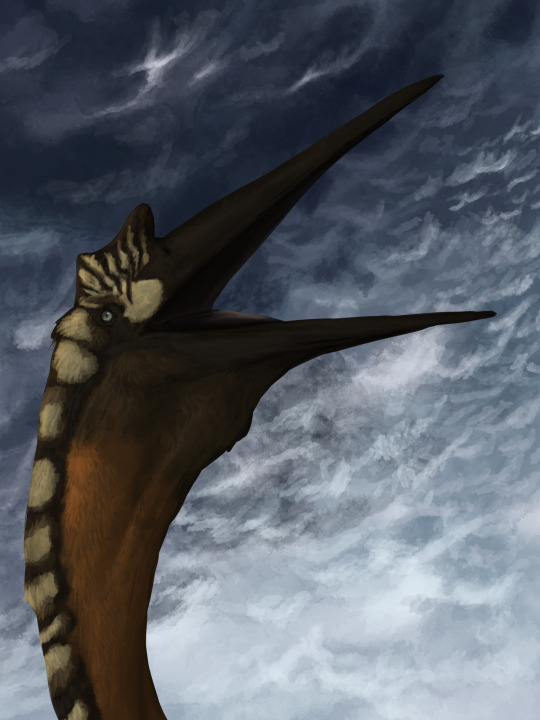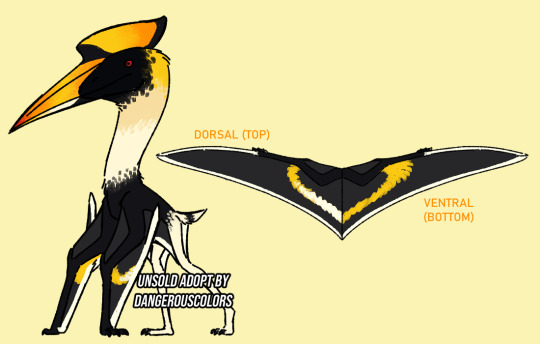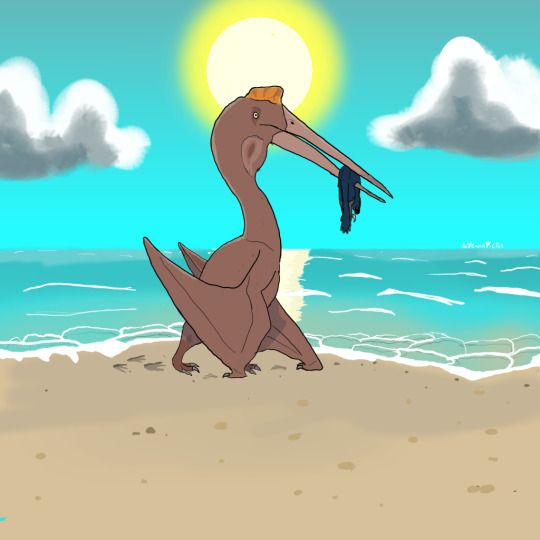#Quetzalcoatlus northropi
Explore tagged Tumblr posts
Text
You ever think about how incredibly weird Azhdarchids were?
Like, they had huge heads, very long necks, relatively small wings that they could nonetheless fly with, which they (probably) achieved by pole-vaulting themselves into the air with their bones. They could likely get around on land by galloping like horses, and probably ate anything that they could fit in The Beak, like pelicans.
Also they were this big.

Sincerely, what the fuck.
#Quetzalcoatlus#Quetzalcoatlus northropi#Azhdarchid#Azhdarchidae#Pterosaur#Palaeontology#Paleontology
5K notes
·
View notes
Text

Feathered Serpent
#hey ma there’s a weird lizard outside#quetzalcoatlus#quetzalcoatlus northropi#paleoart#pterosaur#azdarchid#my art
20 notes
·
View notes
Text

Artfight attack for @jurassicjerks
#paleoart#art#digital art#paleontology#palaeoart#digitalart#quetzalcoatlus#quetzalcoatlus northropi#pterodactyloidea#pterosaur
394 notes
·
View notes
Text
These graphics from Your Dinosaurs Are Wrong Quetzalcoatlus episode are so funny out of context
Like:

[GIF ID: A paper animation that shows a pterosaurus from the genre Jeholopterus that then pans to Quetzalcoatlus Northropi being behind it. The size difference is ridiculously big. A speech bubble appears showing the word "Howdy" as being said by the Quetzalcoatlus | End ID]
HOWDY

[GIF ID: A paper animation of the pterosaur species Quetzalcoatlus Northropi. It's head is being scaled up until it gets so big that the pterosaus flops and lands on its neck in a ragdoll-like manner with its hindlimbs dangling in the air]
Me when I come home from my nine to five job

[GIF ID: A paper animation that shows a speculative way that the pterosaur species Quetzalcoatlus Northopi might have fed. The animation has very few frames and shows the prehistoric animal spotting and its prey, wich is represented by a little red ball, raising the prey up with its beak to swallow it and returning to its neutral position in a very fast paced way.]
Big Chickem
This is the Video btw, 100% recommended to all of the paleontology nerds:
youtube
#quetzalcoatlus#quetzalcoatlus northropi#pterosaur#pterosaurs#paleontology#paleo meme#your dinosaurs are wrong#ydaw#prehistoric animals#jeholopterus#Youtube#gif id#gif#my gif edit
26 notes
·
View notes
Text

oh quetzalcoatlus northropi they can never make me hate you
11 notes
·
View notes
Text

Gentle reminder that these 'birdies' must have been huge and scary. The metal bar here reached to my waist. The ground level were the bones stand was way below the level of my feet. and look how tall. (Yeah, that was my favorite skeleton of the whole museum, though.)
Cretaceous Characters - Quetzalcoatlus meets a sub-adult triceratops. Just a silly paleoart cartoon thing of mine.
48K notes
·
View notes
Note
hiii! i have a few questions, sorry if they’re weird…
1. what’s the most difficult part of gaining?
2. how much can you eat in one sitting?
3. would you ever consider recording the noises of your stomach digesting a meal?
4. noticed you like paleontology/ecology - what’s your favorite fossil?
not weird haha!! 1&2 sorta go together—my appetite isn’t what it used to be and i find it hard to eat a LOT in a normal sitting :(( i can’t force myself like i used to lol, but that’s okay!! i can still manage 1/2 a pizza or more and my massive chick fil a meal!!! i looove shakes for this reason too :3
3. maybe!! the fat on my belly definitely muffles it and unless i have smthn that upsets my tummy (garlic), there aren’t many sounds to record <//3
4. favorite fossil like, a singular something dug up of the ground?? i’ve been in the presence of MANY incredible fossils, but a juvenile t-rex maxilla and the bones quetzalcoatlus northropi was named for really both take the cake!! i’m also a fan of the huge pieces of petrified wood you can find out in the west 🥺
#i love me a log of pet wood#my dad dug some up years ago and we have these giant palm logs just laying there#talk#ask
85 notes
·
View notes
Text
i'm trying to do some speculative biology stuff on how dragons could exist: provided i'm thinking of the typical hexapod/six-limbed dragon (four legs and two wings), however, i have to contrive reasons for how the extra set of limbs would arise on a quadruped, and how they'd function (wyvern dragons are much easier to envision, as they're just scarier pterodactyls); i'm also curious as to how dragons would behave given their anatomy. assorted thoughts below...
for one thing, i instantly imagined dragons evolving from dinosairs. i was thinking of some sort of conjoined/parasitic twin mutation common to the dragon species which would add the extra wings, but that idea rested on one twin having the wing-limbs to contribute to the wingless dominant twin, which apparently would be impossible as all conjoined twins are identical (which is pretty obvious now that i think about it). i should still keep the conjoined twins idea in my back pocket, though, so there could be hydras!
maybe the extra limbs would just be a product of polymelia, specifically notomelia... as it is, though, i'm wondering how the mutant extra limbs would evolve into wings fast enough that the mutation could even persist in the population: the presence of the extra limbs would likely be a hinderance for as long as they aren't actively beneficial, after all. maybe i can look into how pterodactyl and archaeopteryx wings evolved to get a sense of how that occurred: for them, too, any evolutionary stage at the midpoint between leg and wing would likely have not been specialized enough in either direction to be helpful, so the transition must've been quick/direct and therefore a product of a single large mutation with subsequent refinements. for dragons, i could imagine two stages, with a simpler, smaller wing evolving in a quick first pass -- giving the animal more air time when leaping -- and a second stage of the wings enlarging to provide the capacity for real flight. (either way i'd imagine that dragons, like birds and mammals, would initially be very small and only evolve to their maximum size after the extinction of the dinosaurs.) i'd have to look more into the occurrence of notomelia and what causes it (does it even occur in reptiles/dinosaurs?), to see how realistic it would be for it to occur commonly within a species and produce fully-functioning limbs.
i'm picturing dragons as carnivorous, meaning they'd likely evolve from theropods: this would make sense, given theropods' hollow bones, as well as their evolutionary proximity to birds. with that in mind, having the wings as an extra set of limbs would be especially beneficial, as all four of the animal's legs could be maintained: the hindlegs for running, and the forelegs for grasping (these would necessarily not be tiny like a t-rex's). also, the idea of feathered dragons is a very fun one: imagine the vivid colors and patterns they could have!
in terms of size, we tend to picture dragons as very large -- however, i'd have to keep in mind that the larger the animal, the harder it will be to maintain lift and fly efficiently, especially if the animal in question has more than four limbs to carry in addition to its body. there have been some genuinely huge flying reptiles and birds in existence, such as quetzalcoatlus northropi (~35 ft wingspan, 440-550 lbs weight) and pelagornis sandersi (~20 ft wingspan, 48-44 lbs weight) -- and these awesome animals were able to fly, despite being so massive! there are several factors that would contribute to this, including the giant wingspan and hollow bones. because of the weight of the extra limbs, i doubt a hexapod dragon could grow quite as massive as quetzalcoatlus and still be able to fly well, though i still think it would be possible for them to be very large; it's worth mentioning, too, that having four legs to power liftoff would make it more viable for a dragon to take to the skies at all.
in myth, dragons often breathe fire; i don't think i could manage to find a reasonable biological means of that evolving, though perhaps dragons could evolve to spit venom, which would be a more realistic means of delivering a ranged, burning attack. in flight, the dragon could take down its prey by targeting it with venom, then quickly snatch it up with its forelegs to eat without ever alighting. sounds evolutionarily beneficial to me: very efficient, and very awesome.
tying into the trope of a greedy dragon's hoard, perhaps dragons are especially keen to shiny objects, which they can see from afar: with this mid-flight grasping maneuver, they'd snatch them up to add to a bowerbird-like nest decorated with "treasure". to connect more with myth, dragons are often associated with weather, storms in particular; perhaps dragons migrate at high altitudes during rainy seasons, creating that correlation.
it should be noted, too, that the reality in which i'm picturing these dragons is one in which humans also exist. these humans, witnessing the behaviors of these awe-inspiring creatures, would tell stories about them: they breathe fire (they spit venom), and they abduct children (they snatch up their prey in their claws), and they steal treasure from kings (they take shiny things for their nests), and they control the weather (they migrate during the rainy season). perhaps humans aren't their main prey source, causing dragons to be a fear but not a genuine threat to humans (like how we view sharks); or perhaps dragons indeed regularly eat humans, meaning humans have to live out of sight of them. in the latter case, considering how dragons are highly effective predators, they might drive humans towards extinction!
i hope you enjoyed my spec-bio ramble on the evolution, physiology, and behavior of dragons! it's very fun to think about :)
#melonposting#dragon#dragons#speculative biology#spec bio#for the record i did not mean to spend so long writing this. i have stuff to do... but i got swept up by the dragons........#i'm the victim of a pincer attack between my adhd and autism i'm afraid. they ganged up on me#oh yeah i should note that i'm not an expert on any of this! if i get something wrong i'd love to be corrected so i can learn more
92 notes
·
View notes
Text




Quetzalcoatlus northropi
#artists on tumblr#paleoart#paleo#paleomedia#paleontology#digital artist#quetzalcoatl#quetzalcoatlus#cretaceous period#late cretaceous#pterosaur#azdarchid
50 notes
·
View notes
Text

Quetzalcoatlus lawsoni by corvarts. Unlike it's larger relative Q. northropi, which occurs in plains deposits, Q. lawsoni occurs exclusively in alkaline salt lake deposits. This seems to hint at a flamingo-like lifestyle, perhaps having displaced ctenochasmatoids in this regard.
184 notes
·
View notes
Text

Hell Creek Bayou
This is my representation of a bayou in the Hell Creek region of western North America between 68 and 66 million years ago, near the end of the Late Cretaceous Period. This region straddles what are now states of Montana, Wyoming, and North and South Dakota, but back then had a humid and semitropical climate more similar to modern Florida or Louisiana. Among the animals you can see in this illustration are the ceratopsian Triceratops prorsus, the tyrannosaurid Tyrannosaurus rex, a pterosaur related to Quetzalcoatlus northropi, and the eusuchian crocodyliform Borealsuchus sternbergii.
#hell creek formation#cretaceous#mesozoic#prehistoric#dinosaurs#tyrannosaurus rex#triceratops#paleoart#illustration#digital art#art
18 notes
·
View notes
Text

new design up for sale! quetzalcoatlus northropi based on the great hornbill (buceros bicornis). 8 usd via paypal invoice.
willing to hold 1 week max! dm to claim
#adopt#adoptable#paleoart#paleoblr#pterosaur#quetzalcoatlus#azhdarchid#azhdarchidae#furry#safe fur work#sfw furry#furry artist#vic.png#my art
46 notes
·
View notes
Text
Arambourgiania philadelphiae

Arambourgiania is an azdarchid pterosaur from the late cretaceous, and is one of several of these pterosaurs to potentially be the largest flying animal ever (along with Hatzegopteryx and Quetzalcoatlus northropi). The type species, A. philadelphinae, was found in Jordan, but similar remains found in North America and Morocco tentatively assigned to the genus could mean it had an almost worldwide distrubution.
The remains we have of Arambourgiania are quite fragmentory, so I decided to be a little experimental with my reconstruction, namely in the shape of its head crest. I originally wanted to colour this piece in, but I got distracted by other things and I kinda like how it is. I still might eventually get round to it though.
Also couldnt decide which photo of it to go with soooo... have a bonus version :)

#paleoart#arambourgiania#azdarchid#pterosaur#late cretaceous#cretaceous#prehistoric#might finish this idk
8 notes
·
View notes
Text
ive said this before but if i could pick one type of prehistoric animal to revive it might be trilobites. i just feel like they're really iconic earth animals and deserve a spot back on the roster. they could fit right back in home aquarium enthusiasts could collect them etc. they could be a beloved mild curiosity akin to funny colored shrimps or cool bugs. that or quetzalcoatlus northropi so i can watch videos on the internet of it eating entire live horses
10 notes
·
View notes
Note
Sorry I’m dumb they’re not birds. They’re the Hatzegopteryx and Quetzalcoatlus northropi
How was I supposed to remember those names anyway😔💔
that type of pterosaur is called an azhdarchid it if helps
(it doesn't! gesundheit.)
48 notes
·
View notes
Text

Snack At The Beach
A Quetzalcoatlus northropi feasting on a juvenile troodontid at the beach, in Texas 66 MYA.
14 notes
·
View notes